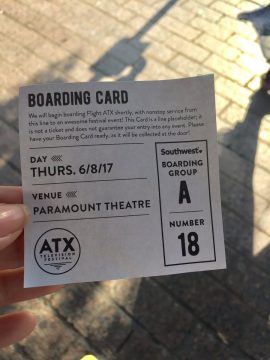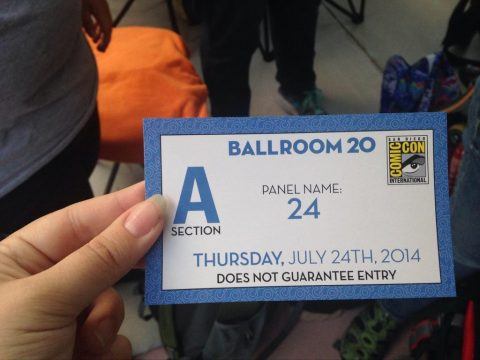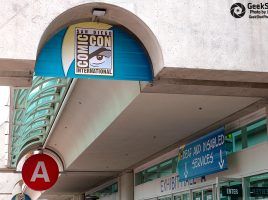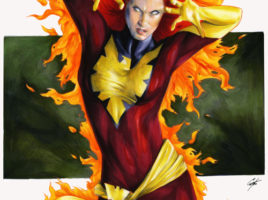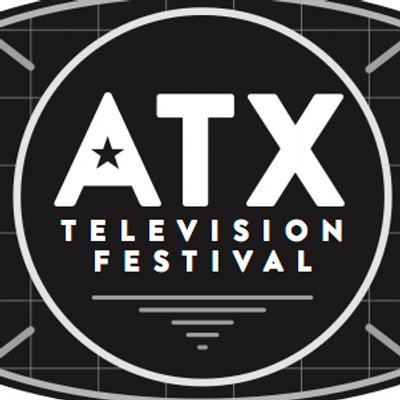 It may sound strange to think that a small festival of only about 2,500 attendees in Austin, Texas, has things to teach mega San Diego Comic-Con — but ATX TV Festival was one of the best run events I’ve been to in a very long time (and one of the most fun — you can read my review of this year’s events here). Obviously, it’s not an apples to oranges situation. What works for a panel room of 300 may not work for a panel room of 6,000 — but ATX has managed to offer up some new ideas for line management and organization that improve the wheel, rather than reinvent it entirely. There may be some lessons to learn, or if nothing else, a chance to see how many of the ideas tossed around for how to improve San Diego work in practice rather than in theory.
It may sound strange to think that a small festival of only about 2,500 attendees in Austin, Texas, has things to teach mega San Diego Comic-Con — but ATX TV Festival was one of the best run events I’ve been to in a very long time (and one of the most fun — you can read my review of this year’s events here). Obviously, it’s not an apples to oranges situation. What works for a panel room of 300 may not work for a panel room of 6,000 — but ATX has managed to offer up some new ideas for line management and organization that improve the wheel, rather than reinvent it entirely. There may be some lessons to learn, or if nothing else, a chance to see how many of the ideas tossed around for how to improve San Diego work in practice rather than in theory.
Boarding Cards
San Diego Comic-Con started doing cards (and Hall H wristbands) that indicate A-D sections several years ago before the first panel of the day. As you can see from the photo below, the card doesn’t guarantee entry — it basically just gives you a rough idea of which quarter of the room you’re likely to be in. Have an A card? Odds are high you’re getting in and will have a good seat. Have a D card or wristband? You will probably make it in, but you definitely won’t be anywhere near the Hall H stage.
ATX takes this one step further, by handing out “Boarding Cards” that also indicate the boarding group (A, B, etc) — but they also have exact line placement numbers. So, for instance, I was the 18th person in line for the Snowfall panel, and my card states that my number is A-18. That means I know exactly where I am in line, and can better gauge my position. Line-camping is definitely not a thing at ATX, but just imagine the implications at San Diego: You could prove line-cutting.
Obviously, handing out 6,000 or so individual cards/wristbands for Hall H would be a logistical nightmare, but surely there’s a middle ground? Maybe instead of grouping attendees into quarters at San Diego, which leaves an awful lot of wiggle room for people trying to sneak up closer in the line (after all, even if you move up 1,000 places in line, if you have the same colored wristband as the other people around you, who can prove it?), we could make the wristbands into colored sections of 200. It would also be great if you had to hand in your card/wristband when entering the hall similar to ATX, so that no one can just jump in the line and hope that no one happens to notice they weren’t there earlier.
Fastpasses
I’m not sure I ever envision Comic-Con International moving to more of a lottery-based process for panels (but everything else is a lottery, so maybe!), but it’s been the subject of a lot of talk for several years among attendees. So it was interesting to finally see such a system in place.
At ATX after the schedule is released, attendees are given a few days to login to a system and list their top eight panels in order of preference. Then the system closes, everyone is randomized, and you are guaranteed to come out with four of your eight choices (not necessarily your top four choices, but you will get some combination of four out of the eight panels you submitted for). Each panel has about 1/3 of space reserved for the fastpass line, and then the remaining seats are saved for a stand-by line, who get in after fastpass.
Again, this is the kind of thing that obviously works better in a setting of 2,500 compared to 135,000 — but it was also about the happiest I’d ever seen attendees. Most of the stress was gone, because even if you found yourself unlikely to get into one panel, at least you knew you had a guaranteed panel waiting for you another time.
What would a system like this look like for San Diego Comic-Con? Definitely not as streamlined as this. It would probably be more along the lines of, “Rank 50 panels and we will guarantee you entrance into one” (kidding — kind of), but it’s interesting to consider regardless.
Types of Panels
On paper, the Entertainment Weekly presented Battlestar Galactica reunion that happened at ATX this year seems like the kind of event that’s tailor-made for San Diego Comic-Con. Big, splashy, ground-breaking sci-fi show celebrates its history – surely that belongs at San Diego, right? But the more I’ve thought about it, the less sense it makes. There’s no brand new Blu-ray to promote, and it’s not a big reunion year (it’s been 13 years since the series began airing, and 8 since it went off the year). There’s no reason to celebrate it except that it deserves celebrating. That’s not what Comic-Con does, except with their Spotlight panels for special guests, and a handful of others (for instance, TV Guide did host an X-Files reunion panel a few years ago).
But maybe it should be. San Diego is in a very unique position in that beyond their Spotlight panels, they don’t really have to program their own panels. Everyone just brings them to them – which is why almost every panel with professionals is selling something, whether it’s “Come watch our show” to “Come buy our comic”. There’s nothing wrong with that, but it was so refreshing at ATX to see victory laps for the recently-ended The Leftovers and Girls. Whereas at San Diego, even if those series had attended in the past (and still sad we never got a The Leftovers panel, HBO), there’s no possible way they would attend in 2017 because their runs have ended. And forget about reunion panels organized by ATX for long-since-cancelled shows like The Middleman, October Road, The Black Donnelleys, and Northern Exposure. ATX is less of a PR-machine, and more about celebrating the craft – and I wish there was more of that at San Diego.
Now, in all fairness, Comic-Con International hosts more panels than virtually any other convention, and there’s a huge range of topics and mediums that they cover. But the attitude of “we’re hosting a panel with professionals just because we care” is definitely better represented on the comics and literary side, where you often get panels with legendary writers and artists just discussing their lives, their influences, and their work for no reason other than that they’re passionate about it and so are the fans. It’s also pretty well-represented in the behind-the-scenes looks at TV and movies, where you’ll often find composers, costume designers, and special effects professionals discussing their collective experiences for an hour. But there’s always room for improvement.

What ATX Could Improve On
On the other side of that coin, ATX is obviously not a perfect event. My first day when I asked how line-up would work for a panel, and was told, “We were supposed to have signage, but it was never delivered, so we’re still trying to figure some of that out.” If there’s one thing San Diego should be able to teach the rest of the world, it’s that there’s no such thing as too much signage – or too many volunteers, for that matter.
On that note, the panels desperately needed one more volunteer in each room, whose job was to motion to the moderators when there were 15 minutes remaining, and again when there were 5. Of the panels I attended, not a single one ended on time (which led to people having to awkwardly try to sneak/run out to make it to another event on time, something which clearly upset Graham Yost in the Sneaky Pete panel) and some moderators commented at the end, “I think I forgot to take reader questions.” A simple gesture or comment to the moderators would have made a huge difference.
The stage in the SFA Ballroom also needed to be raised, which meant that attendees further back than about row seven didn’t have much of a view. I heard some folks suggesting stadium seating (which Nerd HQ thankfully added last year after having a similar problem in 2015), but the ballroom is likely too large for that too work.
ATX and San Diego Comic-Con are two completely different beasts – but that doesn’t mean there aren’t lessons to learn from both.



